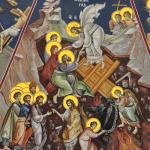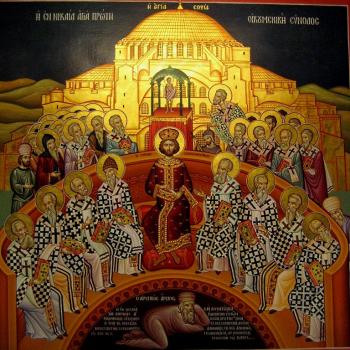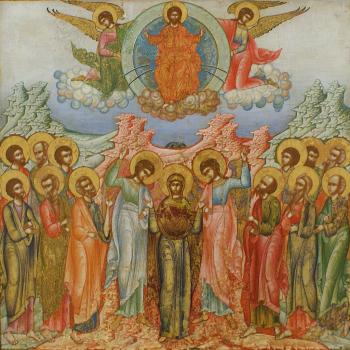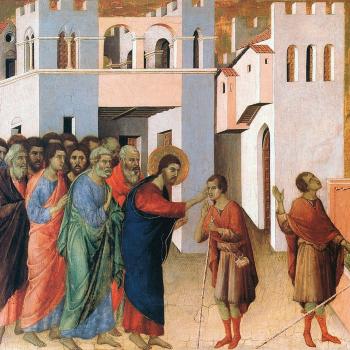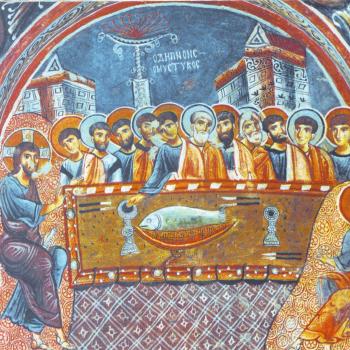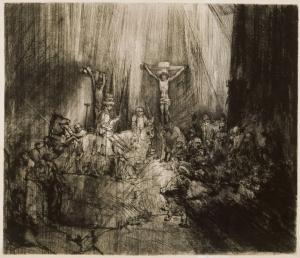
By accepting a place next to criminals, next to those recognized as public sinners, Jesus demonstrated his love and solidarity for all sinful humanity on the cross. Throughout his public ministry, he was around those who were outcast and despised, those considered ritually or spiritually impure. They were the ones who welcomed Jesus. They were the ones who welcomed his message of love and hope. They were the ones who accepted his spiritual and physical healing. The kingdom of God was for them. Thus, wherever Jesus could be found, Balthasar suggests, he was with lawbreakers:
This undeniable fact is merely the final realization of Jesus’ solidarity with mankind. To be human essentially means to identify with one’s fellowmen, and Jesus’ entire life was lived together with real lawbreakers, regardless of whether they were of the pious or impious sort.[1]
This is why it was appropriate for Jesus to be crucified next to those civil authorities considered to be lawbreakers. As he was in life, so he would be in death, revealing the kingdom of God to whoever would welcome his message.
While the two criminals have often been said to be thieves, many scholars think it is likely that they really were rebels fighting against Rome. Perhaps, as a part of their rebellion, they confiscated property from authorities, making them also thieves. Nonetheless, it would have been as political rebels, as zealots fighting against Roman authority, which would have earned them their deaths. This is why Jesus was placed next to them. Pilate treated Jesus as a political rebel; putting him next to other such rebels would only have strengthened the message he wanted to give to the people of Israel: they cannot fight against Rome and win.
The statements given by the two criminals, named Gestas and St. Dismas by tradition, helps strengthen the case that Jesus was crucified next to other would-be rebels:
One of the criminals who were hanged railed at him, saying, “Are you not the Christ? Save yourself and us!” But the other rebuked him, saying, “Do you not fear God, since you are under the same sentence of condemnation? And we indeed justly; for we are receiving the due reward of our deeds; but this man has done nothing wrong.” And he said, “Jesus, remember me when you come into your kingdom.” And he said to him, “Truly, I say to you, today you will be with me in Paradise” (Lk. 23:39-43 RSV).
Gestas, the first criminal, knew the claims which had been made about Jesus. Like many others, he believed the messiah would reveal himself as he used his power to free Israel from Roman rule. We can read Gestas as if he were asking Jesus, “If you truly are the Christ, as many believe, isn’t it time to act?” By asking this, Gestas was once again tempting Jesus to use his power and use it to establish an earthly kingdom. Gestas asked to be saved, but the salvation he wanted was not for his soul, but for his body, to be set free from his cross and to be allowed to partake in an earthly messianic kingdom. He would lend his support to Jesus’ cause if Jesus only acted in the way everyone expected the messiah to act.
Gestas was short-sighted, but St. Dismas, on the other hand, was moved by the display of Jesus’ humility. He saw and understood something was going on beyond Gestas’ simple messianic expectations. Dismas believed in Jesus and that he was fulfilling his messianic function, but that the messianic kingdom was something beyond what Dismas and Gestas expected it to be like. Dismas seemed to get a glimpse of Jesus’ true messianic glory, the glory of the God-man who emptied himself on the cross, Dismas bowed down to it. He knew that both he and Gestas were guilty as charged, that they had done all kinds of evil things for the sake of their rebellion. They thought they would be justified what they did, like all consequentialists, by the good which they believed they would achieve. But now, dying next to Jesus, he saw that there had been and would be no such justification. They had fought against Rome and lost. Likewise, what they wanted to achieve was wrong. All they wanted to do was replace Rome. Jesus, on the other hand, was not tainted by such evil. Seeing this, Dismas acknowledged his own wickedness, and that of his companion, Gestas, and how different their circumstances were with those surrounding Jesus. Dismas, going over to Jesus in faith, asked Jesus to remember him in his kingdom.[2] Jesus, seeing the faith of Dismas, affirmed it, and promised Dismas he would be received in paradise, free from sin, because his faith had made him whole.
Thus, we see Jesus between two criminals, but also between two understandings of the messianic kingdom. One vision was of a purely earthly glory which would be established and preserved by might. This is what people expected. Many rejected him when it was clear this is not what he would do. The other is the mysterious kingdom of God revealed in God’s self-giving love. The true kingdom of God, the kingdom of life, would only be revealed once the Son of God had finished his incarnational kenosis by his descent into the dead.
Jesus was comforted by and aided by St Dismas, as St Dismas affirmed Jesus’ final rejection of the temptation to power. Dismas rebuked Gestas for Jesus, and so made way for the revelation of the true kingdom of God. Gestas did not conceive of the transcendent kingdom of God, and so, for him, to be saved was only to experience a short-term victory against his earthly enemies. Gestas, like so many of us, had only a limited view of Jesus. He wanted to use Jesus for his own earthly desires instead of following Jesus and the path Jesus set up to true happiness in the kingdom of God.
“For the word of the cross is folly to those who are perishing, but to us who are being saved it is the power of God” (1 Cor 1:18 RSV). The self-emptying of God on the cross, the death of God on the cross, appears to be foolishness to those who look for and want mere temporal power because God’s self-surrender is the ultimate rejection of such a will-to-power. But to those who look beyond appearances, the power of love is revealed, a power which is greater than all that is lost in God’s self-emptying. Self-emptying love reveals itself to be greater than the power of death itself. Or, as St Peter Chrysologus suggests, “Therefore, since he is willing to die, it is not a mishap, but an act of power.”[3] Dismas, sensing this, came to understand the transcendent reality of the kingdom of God and came to find himself welcome in the kingdom of God because of his own self-denial to Christ. No longer would he have to fight and kill others to create the kingdom of God. Now he would humbly accept his own death and await God’s judgment.
Redemption is an act of God’s love, whereby Jesus, the God-man, willingly follows humanity all the way to the cross – and Hades, in order to unveil the love which had otherwise been hidden by the “countenance of justice,” as Bulgakov theologizes
Thus, on the part of Divinity, redemption is love’s sacrifice of itself for the salvation of the world: the countenance of love is veiled by the countenance of justice, in virtue of which sin must be suffered to the end in order that its bearer may be reconciled with God, even if this Bearer is the only one without sin, the Son of God. [4]
The cross works to unveil God’s love. Through it, we are shown that the transcendent love of God goes beyond the mere appearance of justice. Justice without love leads only to hell. And so the God-man, unveiling himself of the form of justice as a part of his kenotic self-emptying, allows the ultimate revelation of God to be established. Show gives us the ultimate revelation of God as love, and not any kind of love, but self-sacrificial love which does not grasp after any external form of glory (such as justice) to use as a barrier between him and his creation. Just as the sinner must divest themselves of sin, emptying themselves from all attachments which keep them from living out their lives as reflections of God’s love, so God empties himself in the God-man of all the barriers which could be put in place between him and sinners. He completely opens up the way for their reconciliation to him. Love knows no boundaries, no barriers, no attachments, nothing of the mine or thine which sin dualistically establishes in the world. Gestas wanted to continue with such duality and read the messianic kingdom under its mantle, while Dismas finally understood and divested himself of all he had been and was so that he can be welcomed face to face in the true kingdom of God.
St. Dismas understood. Do we? St. Dismas accepted his death and allowed himself to die, not just physically, but spiritually, so as to be restored to his original face which he had before all sin. Do we understand, or do we still seek Jesus to transform the world in the way Gestas and many others thought the messiah would? We must accept the challenge of the cross. We must follow Jesus in the denial of worldly power. We must follow all the way through with death to the self. Then, like St. Dismas, we will reveal we have truly understood the message of the cross:
The announcement of his death set the image of the Crucified One before his disciples, and even today sets it before one who reads or hears the gospel. Therein lies a silent challenge to response appropriately. The appeals to follow on the way of the cross of life present the appropriate response and at the same time give an insight into the meaning of death on the cross. For upon the words of invitation there follows immediately the admonition: “Whoever wishes to save his life will lose it; but whoever loses his life for my sake, will save it.” Christ gives up his life in order to open the way to eternal life for humanity. However, to win eternal life, they too must give up their earthly life. [5]
All of this must not be interpreted gnostically, as a rejection of the world. We must not ignore the problems of the world. Jesus throughout his ministry helped people in their miseries. What we must do is deny our attachment to the world. We must engage it with a new mode of engagement. We must not allow ourselves to be guided by the selfish ego and the false self it establishes for us; rather, we must engage the world with pure love, divesting ourselves of all that does not follow a hermeneutic established by love. We must take up the cross, follow Jesus, and find ourselves with St. Dismas. We must let Jesus reveal himself to us and accept the folly of the cross, the folly of love, so that we can find the kingdom of God and live in it even as we remain in time, continuing the work of Jesus’ loving mission to others. Then we will be like Paul, saying to others, “For I decided to know nothing among you except Jesus Christ and him crucified” (1 Cor. 2:2 RSV), because in and through all things we do, we will do with Christ-crucified, the kenotic love of God. Then we will be able to see God face to face for Christ, as there will no longer be a barrier between us and him.
[1] Hans Urs von Balthasar, You Have Words of Eternal Life. Trans. Dennis Martin (San Francisco: Ignatius Press, 1991), 251.
[2] Some tradition suggests that the tie might have come from their mutual youths, when Dismas, as an infant, was healed from the bathwater of the infant Jesus, indicating that Dismas would later be healed from his sins by Jesus.
[3] St. Peter Chrysologus, Selected Sermons. Volume 3. Trans. William. B. Palardy (Washington, DC: CUA Press, 2005), 1 [Sermon 72A].
[4] Sergius Bulgakov, The Lamb of God. Trans. Boris Jakim (Grand Rapids, MI: William B Eerdmans Publishing Co, 2008), 363.
[5] St. Edith Stein, The Science of the Cross. Trans. Josephine Koeppel, OCD (Washington, DC: ICS Press, 2003), 17-18.
Stay in touch! Like A Little Bit of Nothing on Facebook.
If you liked what you read, please consider sharing it with your friends and family!



